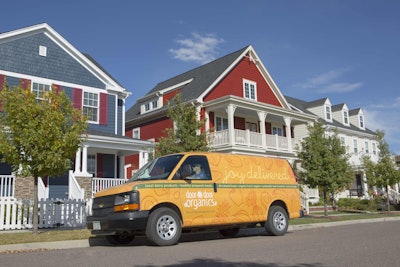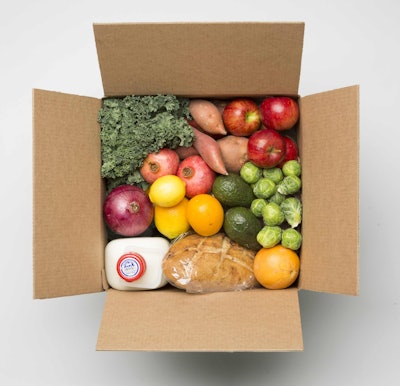Experts predict the online grocery industry will grow from 2 percent of the $650 billion spent annually on domestic groceries to between 10 and 17 percent by 2023.
The business model looks appealing, at least on paper. With a single warehouse and a small fleet of delivery vans, an online grocer is able to serve a large city without the overhead of a chain of brick-and-motor stores.
 Door to Door Organics eliminated the inefficiency and errors caused by having to manipulate its home delivery routes manually every day. CLICK on the photo to see more.
Door to Door Organics eliminated the inefficiency and errors caused by having to manipulate its home delivery routes manually every day. CLICK on the photo to see more.Despite the cost advantage, the model is challenging. Most online grocers charge a delivery fee to make money. While this fee is acceptable to some consumers, many may not be willing to pay extra for something they can do themselves at a neighborhood store.
Door to Door Organics has taken a different approach by offering a subscription model. Its customers can sign up and shop online for local, natural and organic food delivered to their home at no extra charge on a weekly or biweekly schedule.
The business is all about “empowering people to eat good food” through a curated experience where customers can plan meals and shop by recipe. By clicking on a featured recipe on Door to Door’s website, the main ingredients are added to a weekly delivery box to go along with staples such as milk and eggs.
In August 2013, the specialty online grocer changed the process it was using to route its deliveries to increase efficiency and set the stage for continued growth. Since then, its order volume has increased by 20 percent, while labor costs in its logistics department have dropped by more than 10 percent.
To view a quick photo gallery of Door 2 Door’s innovations, click here.
Optimized routing
Door to Door currently delivers in 11 markets and 30 Midwest cities to more than 35,000 active customers. Its current network covers most of Colorado and Michigan and the metropolitan areas of Chicago, Philadelphia and Kansas City, Mo.
The predictability of its subscription model helps keep delivery costs under control. About half of its orders are on a recurring weekly schedule; for most of its residential areas, Door to Door lets customers choose the day of the week for delivery.
The other half of its orders are dynamic; they change daily as new customers sign up and when existing customers change orders such as skipping a week or changing their delivery day.
 CLICK on the image to view a lineup of CCJ’s 2014 innovators.
CLICK on the image to view a lineup of CCJ’s 2014 innovators.Door to Door manages new orders by opening and closing days that are available for delivery. This helps distribute orders to the days of the week where it needs more volume, or density, to balance its routes. On average, the company delivers 65 orders per day on each ZIP code route, says Aaron Peele, outbound logistics manager.
Prior to August 2013, the outbound logistics team had been using a commercial software package to determine the most efficient way to route orders each day. It used the software to optimize orders for delivery after its deadline had closed.
Door to Door gave its customers five days from the day they received a delivery to finalize their next weekly order. If a customer received a delivery on Friday, he had until 8 a.m. on Thursday of the next week – the day before the delivery – to finalize his next order online.
With this process, the logistics team waited until 8 a.m. on the day before the delivery to begin the route planning process. The company used the software to determine the optimal least-cost route plan for all orders in the system at that time. This dynamic routing process required a lot of adjustments afterward to keep its routes consistent.
 By clicking on a featured recipe on Door to Door Organics’ website, the main ingredients are added to a weekly delivery box to go along with staples such as milk and eggs. Click on the photo to see more.
By clicking on a featured recipe on Door to Door Organics’ website, the main ingredients are added to a weekly delivery box to go along with staples such as milk and eggs. Click on the photo to see more.“The trouble with dynamic routing is that we know that drivers and customers prefer consistent routes, but how do you get regular routes when half of the customer base is changing each day?” Peele says.
The company continually was overhauling its routes manually to make them similar to the previous week while including all new orders from the current week. This process took time and left its warehouses waiting on the logistics department to finalize route plans so they could start preparing boxes for delivery.
Extending the deadline
Door to Door created a process to eliminate the inefficiencies and errors caused by having to manipulate its routes manually every day. The new “master route” planning strategy starts by importing the saved routes from the previous week into its routing software system.
With the master routes for an area shown on a map interface, logicians can view all new orders. Next, they manually drag each new order into one of the the adjacent routes shown on the screen, Peele says.
Although this process still has some manual elements, the company is able to strike a balance between the efficiencies of dynamic routing (using fewer miles and resources) and static routing (keeping drivers on the same routes). The outbound logistics department reoptimizes its master routes about every six weeks, Peele says.
With this process, the logistics department is able to complete about 90 percent of the route planning before order cutoff. The company passed the time savings onto its customers; it extended its order deadline from 8 a.m. to noon on the day before delivery.
The customer service department has been spending less time on the phone and responding to emails from customers who otherwise would want to change an order past the 8 a.m. deadline. The new planning process also has improved the quality of Door to Door’s routes.
Shortly after noon on the day before delivery, the company’s warehouses have the full route plan with the contents of each order and delivery sequence for each route. With this information, they can prepare and stage boxes for delivery. On the morning of delivery, the orders are packed on an assembly line and sent out the door to a fleet of vans.
Same-day delivery
With its new route planning process, Door to Door is planning a new option that will allow customers to extend the order deadline to the actual date of delivery for a small fee.
This option is possible by putting the same-day orders on the same routes that were created the previous day without having to rebuild or reoptimize the routes. Without the master routes strategy, same-day orders would be cost-prohibitive to the company and its customers, Peele says.
Door to Door plans to introduce the same-day delivery option in an incremental fashion. The company will start by offering it to customers close to its warehouses. After building awareness of the same-day delivery option, it plans to build up enough demand and density to expand the service to an entire metropolitan area.
The same-day delivery will work as long as a pre-planned route is scheduled to leave a warehouse after the order deadline, such as 10 a.m. on the day of delivery.
“Hopefully, it will not cost us much more, if anything at all,” Peele says. Charging a fee for same-day deliveries will help offset some delivery costs, but he anticipates it mostly will be a customer service tool.
Door to Door recently closed on another round of funding, which brought in another $25 million to accelerate its growth. With its efficiency gains and its curated subscription model for e-commerce, the company has positioned itself as one to watch. This year, its revenues are on a trajectory to increase by more than 40 percent from $35 to $50 million and its customers to increase 20 percent, Peele says.












